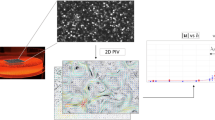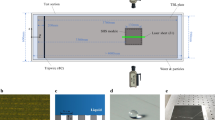Abstract
Processes of the formation of wind waves remain poorly understood, despite numerous studies. One of the main reasons, in our opinion, is that simplified theoretical analysis does not take into account the weak film of natural contaminants. In the present work, wave generation in two channels is experimentally studied and compared for ethanol, water, and water with the addition of a soluble surfactant (sodium dodecyl sulphate (SDS)) in various concentrations. These concentrations hardly affect the surface tension coefficient, but they lead to a significant modification of the subsurface flow structure. In ethanol, the surface film is not formed, so it can be considered a reference case. In water and water with the surfactant, the film is broken and the surface becomes pure at certain critical wind speed, which grows for increasing surfactant concentration. For the surface to remain pure, the contaminant adsorption to the surface must be compensated by its removal by the tangential stress. Three experimental techniques are used to study the influence of cool skin on the formation of the wind waves. The surface relief is measured with modified color schlieren technique and the liquid velocity fields are determined with particle image velocimetry (PIV). The surface temperature fields, which allow the identification of the regions of the rupture of cool skin, are obtained with IR thermography. IR thermography is also used to study the surface velocity field (IR PIV). The film is shown to have significant influence on both the wave amplitude and the structure of subsurface flow.









Similar content being viewed by others
REFERENCES
Banner, M.L. and Peirson, W.L., Tangential stress beneath wind-driven air-water interfaces, J. Fluid Mech., 1998, vol. 364, pp. 115–145.
Benetazzo, A., Fedele, F., Gallego, G., Shih, P.-C., and Yezzi, A., Offshore stereo measurements of gravity waves, Coast. Eng., 2012, vol. 64, pp. 127–138.
Chernous’ko Yu.L. and Shumilov, A.V., Evaporation and microconvection in a narrow surface layer, Okeanologiya, 1971, vol. 11, no. 6, pp. 982–986.
Deskos, G., Lee, J.C.Y., Draxl, C.A., and Spraque, M.A., Review of wind-wave coupling models for large-eddy simulation of marine atmospheric boundary layer, J. Atmos. Sci., 2021, vol. 78, no. 10, pp. 3025–3045.
Druzhinin, O.A., On the dynamics of a drift flow under low wind, Izv., Atmos. Ocean. Phys., 2021, vol. 57, no. 6, pp. 650–658.
Fedorov, K.N. and Ginzburg, A.I., Pripoverkhnostnyi sloi Okeana (The Near-Surface Layer of the Ocean), Leningrad: Gidrometeoizdat, 1988.
Golitsyn, G.S., Statistika i dinamika prirodnykh protsessov i yavlenii: Metody, instrumentarii, rezul’taty (Statistics and Dynamics of Processes and Phenomena: Methods, Tools, and Results), Moscow: Krasand, 2013.
Izzet, A., Moerman, P.G., Gross, P., Groenewold, J., Hollingsworth, A.D., Bibette, J., and Izzet, J.B., Tunable persistent random walk in swimming droplets, Phys. Rev. X, 2020, vol. 10, p. 021035.
Jähne, B., Klinke, J., and Waas, S., Imaging of short ocean wind waves: A critical theoretical review, J. Opt. Soc. Am. A, 1994, vol. 11, no. 8, pp. 2197–2209.
Kandaurov, A.A., Troitskaya, Yu.I., Sergeev, D.A., Vdovin, M.I., and Baidakov, G.A., Average velocity field of the air flow over the water surface in a laboratory modeling of storm and hurricane conditions in the ocean, Izv., Atmos. Ocean. Phys., 2014, vol. 50, no. 4, pp. 399–410.
Katsaros, K.B., Liu, W.T., Businger, J.A., and Tilman, J.A., Heat transport and thermal structure in the interfacial boundary layer measured in an open tank of water in turbulent free convection, J. Fluid Mech., 1977, vol. 82, no. 2, pp. 311–335.
Keane, R.D. and Adrian, R.J., Theory of cross-correlation analysis of PIV images, Appl. Sci. Res., 1992, vol. 49, pp. 191–215.
Kosnik, M.V. and Dulov, V.A., Extraction of short wind wave spectra from stereo images of the sea surface, Meas. Sci. Technol., 2011, vol. 22, no. 1, p. 015504.
Kou, J., Judd, K.P., and Saylor, J.R., The temperature statistics of a surfactant-covered air/water interface during mixed convection heat transfer and evaporation, Int. J. Heat Mass Transfer, 2011, vol. 54, pp. 3394–3405.
Kudryavtsev, V., Shrira, V., Dulov, V., and Malinovsky, V., On the vertical structure of wind-driven sea currents, J. Phys. Oceanogr., 2008, vol. 38, pp. 2121–2144.
Lamb, H., Hydrodynamics, New York: Dover, 1945; Moscow: OGIZ, 1947.
Li, T. and Shen, L., The principal stage in wind-wave generation, J. Fluid Mech., 2022, vol. 934, p. A41.
Longo, S., Chiapponi, L., Clavero, M., Mäkelä, T., and Liang, D., Study of the turbulence in the air-side and water-side boundary layers, Coast. Eng., 2012, vol. 69, pp. 67–81.
Miles, J.W., On the generation of surface waves by shear flows, J. Fluid Mech., 1957, vol. 3, no. 2, pp. 185–204.
Moisy, F., Rabaud, M., and Salsac, K., A synthetic Schlieren method for the measurement of the topography of a liquid interface, Exp. Fluids, 2009, vol. 46, pp. 1021–1036.
Monin, A.S. and Krasitskii, V.P., Yavleniya na poverkhnosti Okeana (Phenomena on the Ocean Surface), Moscow: Gidrometeoizdat, 1985.
Monin, A.S. and Yaglom, A.Ya., Statisticheskaya gidromekhanika (Statistical Hydromechanics), vol. 1, Moscow: Nauka, 1965.
Pawliszak, P., Ulaganathan, V., Bradshaw-Hajek, B.H., Manica, R., Beattie, D.A., and Krasowska, M., Mobile or immobile? Rise velocity of air bubbles in high-purity water, J. Phys. Chem. C, 2019, vol. 123, pp. 15131–15138.
Phillips, O.M., On the generation of waves by turbulent wind, J. Fluid Mech., 1957, vol. 2, no. 5, pp. 417–344.
Plaksina, Yu.Yu., Pushtaev, A.V., Vinnichenko, N.A., and Uvarov, A.V., The effects of small contaminants on the formation of structures during Rayleigh–Bénard–Marangoni convection in a planar liquid layer, Moscow Univ. Phys. Bull., 2018, vol. 73, no. 5, pp. 513–519.
Raffel, M., Willert, C.E., Scarano, F., Kähler, C.J., Wereley, S.T., and Kompenhans, J., Particle Image Velocimetry: A Practical Guide, Berlin: Springer, 2018.
Reutov, V.P., Ezerskii, A.B., Rybushkina, G.V., and Chernov, V.V., Convective structures in a thin layer of an evaporating liquid under an airflow, J. Appl. Mech. Tech. Phys., 2007, vol. 48, no. 4, pp. 469–478.
Rudenko, Y.K., Vinnichenko, N.A., Plaksina, Y.Y., Pushtaev, A.V., and Uvarov, A.V., Horizontal convective flow from a line heat source located at the liquid-gas interface in presence of surface film, J. Fluid Mech., 2022, vol. 944, p. A35.
Schlussel, R., Emery, W.J., Grassel, H., and Mammen, N., On the bulk skin temperature difference and its impact on satellite remote sensing of sea surface temperature, J. Geophys. Res., 1990, vol. 95, pp. 13341–13356.
Siddiqui, K. and Loewen, M.R., Characteristics of the wind drift layer and microscale breaking waves, J. Fluid Mech., 2007, vol. 573, pp. 417–456.
Veron, F. and Melvill, W.K., Experiments on the stability and transition of wind-driven water surfaces, J. Fluid Mech., 2001, vol. 446, pp. 25–65.
Veron, F., Melville, W.K., and Lenail, L., The effects of small-scale turbulence on air–sea heat flux, J. Phys. Oceanogr., 2011, vol. 41, no. 1, pp. 205–220.
Vinnichenko, N.A., Plaksina, Yu.Yu., Baranova, K.M., Pushtaev, A.V., and Uvarov, A.V., Mobility of free surface in different liquids and its influence on water striders locomotion, Environ. Fluid Mech., 2018, vol. 18, pp. 1045–1056.
Vinnichenko, N.A., Pushtaev, A.V., Plaksina, Y.Y., and Uvarov, A.V., Measurements of liquid surface relief with moon-glade background oriented Schlieren technique, Exp. Therm. Fluid Sci., 2020, vol. 114, p. 110051.
Yousefi, K., Veron, F., and Buckley, M.P., Turbulent and wave kinetic energy budgets in the airflow over wind-generated surface waves, J. Fluid Mech., 2021, vol. 920, p. A33.
Zavadsky, A. and Shemer, L., Water waves excited by near-impulsive wind forcing, J. Fluid Mech., 2017, vol. 828, pp. 459–495.
Zavadsky, A., Benetazzo, A., and Shemer, L., On the two-dimensional structure of short gravity waves in a wind wave tank, Phys. Fluids, 2017, vol. 29, p. 016601.
Zhang, X. and Cox, C., Measuring the two-dimensional structure of wavy water surface optically: A surface gradient detector, Exp. Fluids, 1994, vol. 7, pp. 225–237.
Zhang, X., Dabiri, D., and Gharib, M., Optical mapping of fluid density interfaces: concepts and implementations, Rev. Sci. Instrum., 1996, vol. 67, no. 5, pp. 1858–1868.
Funding
This study was supported by the Russian Science Foundation, grant no. 22-79-00135. Equipment purchased with funds from the Moscow University Development Program was used.
Author information
Authors and Affiliations
Corresponding author
Ethics declarations
CONFLICT OF INTEREST
The authors declare that they have no conflicts of interest.
ADDITIONAL INFORMATION
This article was prepared on the basis of an oral report presented at the IV All-Russian Conference Turbulence, Atmospheric and Climate Dynamics with international participation, dedicated to the memory of Academician A.M. Obukhov (Moscow, November 22–24, 2022).
Rights and permissions
About this article
Cite this article
Plaksina, Y.Y., Pushtaev, A.V., Vinnichenko, N.A. et al. Influence of a Weak Surface Film on the Formation and Propagation of Wind Waves in a Channel. Izv. Atmos. Ocean. Phys. 59, 583–593 (2023). https://doi.org/10.1134/S0001433823050092
Received:
Revised:
Accepted:
Published:
Issue Date:
DOI: https://doi.org/10.1134/S0001433823050092




